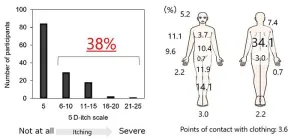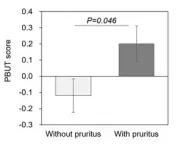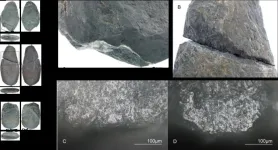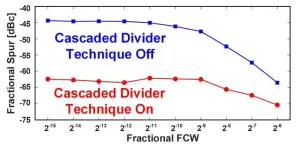Unveiling uremic toxins linked to itching in hemodialysis patients
2024-02-19
(Press-News.org)
Niigata, Japan – Dr. Yamamoto et al. found the several uremic toxins as one of causes of itching in hemodialysis patients. Hemodialysis patients commonly experience itching on a daily basis, which is distributed throughout their bodies. They developed a "PBUT score" based on highly protein-bound uremic toxins (PBUT) that increase in the body with end-stage kidney disease. The PBUT score was associated with itching in hemodialysis patients.
I. Background of the Study
Patients with advanced chronic kidney disease (CKD) require kidney replacement therapy, such as hemodialysis, to manage their condition. Hemodialysis patients often experience various symptoms, leading to a compromised quality of life and reduced activity levels.
Itching is a common symptom frequently observed in hemodialysis patients. Although its exact causes remain unclear, a survey conducted in Japan in 2000 found that itching was present in 73% of hemodialysis patients, and it was associated with elevated levels of β2-microglobulin, calcium, phosphorus, or parathyroid hormone in the blood. Subsequently, improvements in hemodialysis therapy and pharmacological treatments have led to changes in the severity of itching and its associated factors in hemodialysis patients.
Uremic toxins are a group of molecules whose concentrations increase in the blood due to kidney disease. Those molecules are associated with systemic diseases and prognosis in patients with end-stage kidney disease. Among them, molecules with high protein-bound properties, called PBUTs, such as indoxyl sulfate, are difficult to remove by dialysis therapy and have been reported to be associated with various pathologies. However, there have been no reports regarding their association with itching. in hemodialysis patients.
Therefore, Dr. Yamamoto et al. conducted a study to investigate the details of itching and factors associated with it, particularly focusing on PBUTs in hemodialysis patients.
II. Overview of the Study
In this study, Yamamoto et al. investigated hemodialysis patients from dialysis facilities in Japan. Assessing itching using the 5D-itch scale, we found that 38% of patients experienced itching, which was distributed throughout their backs and bodies (Figure 1).
Through principal component analysis of PBUTs including indoxyl sulfate, p-cresyl sulfate, indole acetic acid, phenyl sulfate, and hippuric acid, the PBUT score was generated. Patients with itching had higher PBUT scores compared to those without itching (Figure 2). However, no association was found between itching and previously reported factors such as β2-microglobulin, calcium, phosphorus, and parathyroid hormone.
These results demonstrate an association between PBUTs and itching in hemodialysis patients. Dr. Yamamoto explained that the decreased frequency of itching compared to past reports may be attributed to advancements in treatments such as those involving calcium and phosphorus. The improvement of the removal of PBUTs with dialysis treatment may be beneficial to treat itching in hemodialysis patients.
III. Publication of Research Findings
The research findings were published in the scientific journal "Clinical Kidney Journal" on January 9, 2024.
Paper Title: Pruritus and protein-bound uremic toxins in patients undergoing hemodialysis: a cross-sectional study
Authors: Suguru Yamamoto, Takahiro Tanaka, Kentaro Omori, Isei Ei, Kaori Kikuchi, Ayano Konagai, Shin Goto, Nobutaka Kitamura, Ichiei Narita
doi: 10.1093/ckj/sfae007
END
[Attachments] See images for this press release:


ELSE PRESS RELEASES FROM THIS DATE:
2024-02-19
Communities must be better prepared for flooding in their homes and businesses, an expert warns, as climate change predictions suggest more extreme flooding globally.
Floods still inflict major costs to the economies, livelihoods and wellbeing of communities, with flood risks and impacts set to increase further due to climate change (IPCC, 2021).
Professor of Environmental Management, Lindsey McEwen explains how many experts now believe local communities have critical roles as key actors within flood risk management and disaster risk reduction.
Professor McEwen, author of Flood ...
2024-02-18
Link to video and sound (details below): https://spaces.hightail.com/receive/JwM0o5gQdq
The reproduction of giant sea spiders in Antarctica has been largely unknown to researchers for more than 140 years, until now. University of Hawaiʻi at Mānoa scientists traveled to the remote continent and saw first-hand the behaviors of these mysterious creatures, and their findings could have wider implications for marine life and ocean ecosystems in Antarctica and around the world.
Sea spiders, or ...
2024-02-18
A few years ago, MIT researchers invented a cryptographic ID tag that is several times smaller and significantly cheaper than the traditional radio frequency tags (RFIDs) that are often affixed to products to verify their authenticity.
This tiny tag, which offers improved security over RFIDs, utilizes terahertz waves, which are smaller and travel much faster than radio waves. But this terahertz tag shared a major security vulnerability with traditional RFIDs: A counterfeiter could peel the tag off a genuine item and reattach it to a fake, and the authentication system would be none the wiser.
The researchers have now surmounted ...
2024-02-17
DENVER – Armed with a catalog of hundreds of thousands of DNA and RNA virus species in the world’s oceans, scientists are now zeroing in on the viruses most likely to combat climate change by helping trap carbon dioxide in seawater or, using similar techniques, different viruses that may prevent methane’s escape from thawing Arctic soil.
By combining genomic sequencing data with artificial intelligence analysis, researchers have identified ocean-based viruses and assessed their genomes to find that they “steal” genes from other microbes or cells that process carbon in the sea. Mapping microbial ...
2024-02-17
Embargoed until 1:30 p.m. ET, Saturday Feb. 17, 2024
DENVER – Imageomics, a new field of science, has made stunning progress in the past year and is on the verge of major discoveries about life on Earth, according to one of the founders of the discipline.
Tanya Berger-Wolf, faculty director of the Translational Data Analytics Institute at The Ohio State University, outlined the state of imageomics in a presentation on Feb. 17, 2024, at the annual meeting of the American Association for the Advancement of Science.
“Imageomics ...
2024-02-17
Tokyo, Japan – Researchers from Tokyo Metropolitan University crafted replica stone age tools and used them for a range of tasks to see how different activities create traces on the edge. They found that a combination of macroscopic and microscopic traces can tell us how stone edges were used. Their criteria help separate tools used for wood-felling from other activities. Dated stone edges may be used to identify when timber use began for early humans.
For prehistoric humans, improvements in woodworking technology were revolutionary. While Paleolithic (early stone age) artifacts point to the use of wood for simple tools such as spears ...
2024-02-17
Two innovative design techniques lead to substantial improvements in performance in fractional-N phase locked loops (PLLs), report scientists from Tokyo Tech. The proposed methods are aimed to minimize unwanted signals known as fractional spurs, which typically plague PLLs used in many modern radar systems and wireless transceivers. These efforts could open doors to technological improvements in wireless communication, autonomous vehicles, surveillance, and tracking systems in beyond 5G era.
Many emerging and evolving technologies, such as self-driving vehicles, target tracking systems, and remote sensors, rely on the high-speed and error-free operation ...
2024-02-17
DENVER — Young physician investigators interested in research careers in pulmonology, allergy and immunology, pediatric and related programs, are encouraged to submit basic science or clinical research abstracts by June 3, 2024, to be considered for participation in the 20th Annual Respiratory Disease Young Investigators’ Forum. This year’s Forum will take place October 17-20, 2024, in Denver.
The annual event provides career development and research opportunities for fellows and early career faculty. The Forum is a celebration of talent and ingenuity in respiratory medicine. Physician-scientists in fellowship ...
2024-02-16
In an article published in the Journal of Pediatrics, researchers based in Brazil describe the case of a nine-year-old boy admitted to hospital with multiple symptoms and overlapping conditions that made diagnosis difficult, such as short stature, thin tooth enamel (dental enamel hypoplasia), moderate mental deficiency, speech delay, asthma, mildly altered blood sugar, and a history of recurring infections in infancy.
The team used exome sequencing, in which only the protein-coding portion of the genome is analyzed, to look for genetic mutations, and found them in GCK and BCL11B. ...
2024-02-16
MIAMI, FLORIDA (Feb. 15, 2024) – Prominent oncologist and researcher Damian Green, M.D., will join Sylvester Comprehensive Cancer Center at the University Miami Miller School of Medicine this spring to lead its transplantation and cellular therapy services.
Green will serve as chief of Sylvester’s Division of Transplantation & Cellular Therapy, as well as assistant director of Translational Research, beginning March 1. He joins Sylvester from Fred Hutchinson Cancer Center in Seattle, where he built a distinguished track record in research and ...
LAST 30 PRESS RELEASES:
[Press-News.org] Unveiling uremic toxins linked to itching in hemodialysis patients






